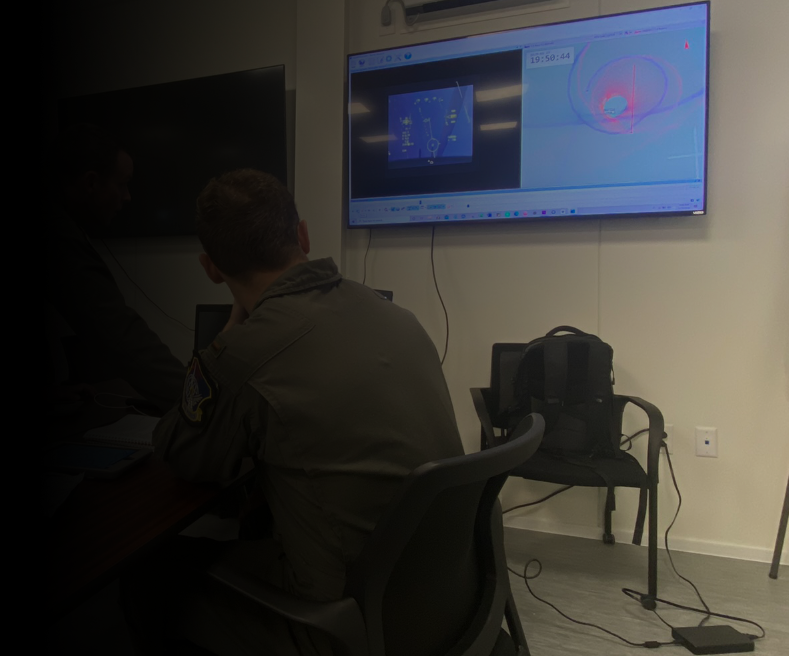Tactical Rejoin Excellence
Transforming Performance Through Visual Cue Mastery

Challenge
A student was struggling with tactical rejoins, an essential skill for maintaining formation integrity. Despite repeated attempts, the student was unable to execute smooth rejoins within the required parameters. This challenge presented several significant issues:
-
Safety Concerns: Imprecise rejoins can create dangerous situations in formation flying, making this skill critical for both training progression and operational safety.
-
Training Progression Barrier: The inability to master this fundamental skill was preventing the student from advancing to more complex formation maneuvers and scenarios.
-
Resource Utilization: Repeated unsuccessful attempts in actual aircraft were consuming valuable flight time and resources without yielding improvement.
-
Conceptual Gap: Standard instruction methods weren't addressing the student's specific difficulty, suggesting a need for a different approach to the skill.
Through careful debriefing, we identified the root cause: the student lacked an understanding of visual cues, particularly how to interpret the line of sight of the other aircraft as indicators for when and how much control input was needed. This perceptual gap was preventing the student from developing the intuitive feel necessary for smooth, consistent rejoins.
Solution
We utilized the simulator to address the issue, creating a focused 10-minute session where the student practiced 10 to 15 tactical rejoins. Our approach was specifically designed to target the identified perceptual gap:
-
Visual Cue Recognition: The session emphasized recognizing and interpreting the correct line of sight cues from the other aircraft, enabling the student to understand when and how to make precise inputs.
-
Compressed Learning Cycle: By conducting multiple rejoins in rapid succession, we created an accelerated learning environment where the student could immediately apply insights from each attempt to the next.
-
Controlled Environment: The simulator provided a consistent, controlled setting where the student could focus exclusively on visual cue interpretation without the distractions and pressures of actual flight.
-
Real-time Feedback: Throughout the session, we provided immediate feedback on the student's interpretation of visual cues and resulting control inputs, allowing for rapid adjustment and refinement.
This targeted approach addressed the specific perceptual skill gap rather than simply providing more practice of the same maneuver. By focusing on the fundamental visual interpretation skills that underlie successful tactical rejoins, we were able to create a breakthrough in the student's understanding and performance.

Attacking Root Cause
Focused Simulation
Created a targeted 10-minute simulator session focusing on tactical rejoin practice.
Visual Cue Training
Emphasized recognition and interpretation of line of sight cues from other aircraft.
Rapid Repetition
Enabled practice of 10-15 tactical rejoins in a compressed timeframe.

Detailed Results
Rapid Skill Acquisition
The student quickly grasped the concept of visual cues, dramatically improving his performance. What had been a persistent struggle transformed into confident execution after just one focused simulator session.
Graduate-Level Performance
He achieved smooth, accurate rejoins within graduate-level competency parameters. This represented not just improvement but a complete transformation to a level of skill that met or exceeded program standards.
Validated Methodology
This targeted intervention reinforced the value of combining root cause analysis with simulator-based training to rapidly build proficiency in critical maneuvers. The approach demonstrated that identifying and addressing specific perceptual gaps is far more effective than generic additional practice.
Efficient Resource Utilization
By achieving mastery in a 10-minute simulator session rather than through multiple actual flights, we conserved valuable aircraft time and resources while delivering superior results.
Transferable Understanding
The student's new understanding of visual cue interpretation transferred to other formation maneuvers, creating benefits beyond the specific tactical rejoin skill that was the focus of the intervention.
Confidence Development
Beyond the technical skill improvement, the student experienced a significant boost in confidence that positively impacted overall performance in formation flying scenarios.
Summary
This case study exemplifies our approach to targeted skill development: identifying specific perceptual or conceptual gaps, designing focused interventions that address those gaps directly, and leveraging simulation technology to create accelerated learning environments. The dramatic improvement achieved in just 10 minutes demonstrates the power of precision in training methodology and the effectiveness of visual cue mastery in formation flying skills.

Rapid Mastery
Quick grasp of visual cue interpretation and application.
Skill Development
Achieved smooth, accurate rejoins within required parameters.

Time Efficiency
Compressed learning through focused simulator sessions.

Performance Standards
Met graduate-level competency requirements consistently.
